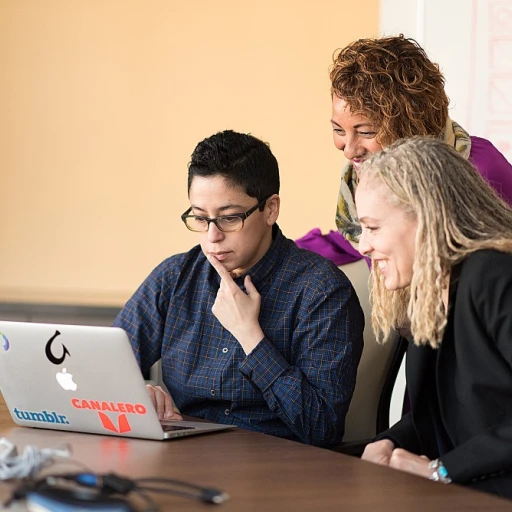
Understanding Ageism: A Workplace Challenge
Ageism and Its Manifestation
Understanding ageism is imperative, especially in today’s diverse work environment. Ageism refers to discrimination based on age, affecting both older and younger employees. It can appear in various forms, from overt actions to subtle biases, influencing how older adults and younger workers perceive their value and potential within an organization.
Defining Age Discrimination
Age discrimination involves unfair treatment of individuals based on which age group they belong to. This discrimination can affect employment opportunities, promotions, and access to resources. In the workplace, it often results in older employees being passed over for promotions or younger employees being treated as inexperienced, regardless of their skills or qualifications.
Impact on People of Different Ages
Both older workers and younger employees face unique challenges due to age-based biases. For older workers, there's often concern over approaching retirement age and the perception of reduced capability, despite extensive experience. On the other hand, younger workers might struggle against assumptions that they're unsuitable for leadership roles, despite their innovative ideas and fresh perspectives.
Consequences for Employment Practices
Ageism can lead to a restrictive work environment, discouraging diversity and inclusion. It hampers the establishment of a culture that values diverse perspectives. Moreover, age bias can negatively influence employee satisfaction and productivity, increasing turnover rates and hindering overall engagement.
Organizations must foster an environment where all employees, regardless of age, feel valued and motivated. By acknowledging the existence of age bias, employers can begin to implement effective strategies to mitigate its impacts. To further explore how to incorporate diversity into the workplace, consider leveraging diversity, equity, and inclusion surveys.
Common Examples of Ageism in the Workplace
Recognizing Subtle and Overt Age Bias
Ageism in the workplace can manifest in various forms, both subtle and overt. Recognizing these examples is crucial for fostering a more inclusive environment. Here are some common scenarios where age discrimination might occur:
- Hiring Practices: Employers may favor younger workers over older candidates, assuming they bring more energy or are more adaptable to new technologies. This age-based bias can lead to older adults being overlooked despite their extensive experience.
- Promotion and Advancement: Older employees might find themselves passed over for promotions in favor of younger employees, based on the assumption that they are nearing retirement age or lack the drive to advance.
- Training Opportunities: Employers may offer fewer training opportunities to older workers, believing they are less likely to benefit from skill development compared to their younger counterparts.
- Workplace Culture: Ageism can be embedded in the workplace culture, where jokes or comments about age become normalized, creating an uncomfortable environment for older employees.
- Performance Evaluations: Older workers might receive biased performance reviews, with their age being unfairly linked to perceived declines in productivity or innovation.
These examples of ageism not only affect the morale of older workers but also undermine diversity and inclusion efforts. To learn more about how age bias impacts employee engagement and the journey of advocating for inclusion, explore this story of employee engagement.
Impact of Ageism on Employee Engagement
The Consequences of Ageism on Employee Morale and Motivation
Ageism in the workplace, whether directed towards older employees or younger workers, can significantly impact the overall employee engagement within an organization. Age-based discrimination typically creates an environment where individuals feel undervalued, leading to a range of negative outcomes that affect not just the targeted age group, but the entire workforce.
For older employees, age discrimination often manifests in assumptions about their ability to adapt to new technologies or their openness to new ideas, despite their vast experience. Such discrimination examples can lead to a decrease in motivation and contribute to a reluctance to contribute fully to their roles. This not only hampers their performance but also affects team dynamics as their colleagues might perceive them as disengaged or uncooperative.
Younger employees, on the other hand, may experience discrimination based on stereotypes around their perceived lack of work experience or reliability. Such bias affects their job satisfaction and may lead them to question their career prospects within the company. As a result, younger workers might become less inclined to seek mentorship within their organizations, missing out on valuable growth opportunities and fostering a culture of high turnover.
Furthermore, an ageism workplace can lead to a fractured work environment where employees ages become a polarizing factor rather than a point of diversity and inclusion. This division often results in reduced collaboration, decreased innovation, and ultimately, diminished productivity across the organization.
Efforts by employers to address and mitigate age bias are crucial, not only for maintaining high employee engagement but also for ensuring a dynamic, cohesive workplace. By acknowledging and addressing these age discrimination examples, organizations reinforce their commitment to an inclusive culture, fostering a more engaged, motivated, and productive workforce.
To dive deeper into how company leaders can shape a more inclusive workplace through mindful communication, explore how the language of leadership plays a pivotal role.
Legal Framework and Policies Against Ageism
Legal Protection Against Age Discrimination
The fight against age bias in the workplace is underpinned by a robust legal framework designed to protect employees from discrimination based on age. One of the primary legal resources is the Age Discrimination in Employment Act (ADEA), which prohibits age discrimination against employees who are 40 years of age or older. This legislation applies to both public and private sector employers with 20 or more employees, ensuring that older workers have equal opportunities in employment. Beyond the ADEA, various state laws also fortify protections by encompassing employees in different age groups, emphasizing diversity and inclusion in the workforce. Employers who disregard these legal mandates risk serious consequences, both legally and reputationally. Legal frameworks aim not only to shield older employees from discrimination but also to encourage fair treatment across the board, aligning with the broader goal of eliminating discrimination workplace practices altogether.Employers' Obligations and Responsibilities
Employers have a critical obligation to understand and implement these legal protections as part of their employment policies. They are encouraged to develop, communicate, and adhere to comprehensive anti-discrimination policies that clearly outline the company's position against ageism workplace issues. Employers must offer training and resources to educate both younger workers and older adults about the importance of respecting a diverse and age-inclusive environment. Moreover, they have the responsibility to handle complaints of age-based discrimination sensitively and with utmost confidentiality. Implementing effective complaint processes allows older employees or any employee experiencing discrimination to voice their concerns without fear of retribution.Creating Policies That Foster Inclusivity
Crafting policies that foster a culture of inclusivity involves more than legal compliance; it requires a genuine commitment to recognizing the strengths that workers of varying age bring to the table. Employers should actively seek to create an environment where age diversity is celebrated. This entails not only preventing age discrimination but also promoting initiatives that enhance age diversity. Examples of successful inclusive policies include mentorship programs that pair older employees with younger employees for mutual learning and the sharing of experiences. Employers can also offer flexible work arrangements that accommodate different life stages, from newly hired younger employees to those approaching retirement age. By ensuring that legal frameworks, employer obligations, and policies are aligned, workplaces can move toward an environment where age discrimination is a relic of the past, ultimately improving overall employee engagement and satisfaction.Strategies to Combat Ageism
Developing Strategies to Address Age Bias
Combating age discrimination in the workplace requires a comprehensive approach that focuses on encouraging inclusivity and leveraging the strengths of diverse age groups. Employers play a crucial role in shaping an environment that values employees of all ages, ensuring equal opportunities for both younger and older workers.
- Training and Awareness Programs: Conduct regular training sessions to educate employees and management on the detrimental effects of ageism. Highlight common examples and discrimination instances to increase awareness and sensitivity, fostering a workplace culture that discourages age-based biases.
- Implementing Mentorship Programs: Establish mentorship opportunities that pair older, experienced workers with younger employees. This initiative promotes knowledge sharing and fosters mutual respect, breaking down age-related stereotypes and encouraging collaboration across different age groups.
- Updating Job Descriptions and Recruitment Practices: Ensure job advertisements and position descriptions are free from ageist language and do not unintentionally favor any specific age group. Adopt age-inclusive recruitment strategies to attract a wide range of candidates, valuing diversity and experience.
- Encouraging Flexible Work Arrangements: Implement flexible work policies that accommodate the different needs of employees at various life stages. This can include flexible hours, remote work options, or phased retirement plans, which can greatly enhance job satisfaction and employee engagement.
- Promoting Diversity and Inclusion Policies: Develop and enforce policies that highlight the benefits of age diversity and inclusion. Regularly review these policies to ensure they effectively support an age-diverse workforce and align with legal frameworks addressing age discrimination.
- Feedback and Communication Channels: Establish open communication channels for employees to express concerns related to age discrimination. Providing a safe space for dialogue encourages transparency and allows the organization to address and rectify any underlying issues promptly.
By adopting these strategies, employers can create a more harmonious workplace environment where employees of all ages feel valued and empowered to contribute to the organization's success. Addressing age discrimination not only enhances employee engagement but also boosts organizational morale and productivity.
Promoting Age Diversity as a Strength
Fostering Age Diversity to Enhance the Workforce
Embracing age diversity isn’t just about compliance with anti-discrimination laws; it helps enrich the workplace environment and fosters greater engagement. Workers from varying age groups bring a breadth of experiences and perspectives that can spark creativity and encourage innovative solutions. Implementing inclusive practices and tackling examples of ageism head-on can improve overall employee engagement. Here are a few strategies employers can consider:- Establish Mentorship Programs: Pair older employees with younger workers. This encourages knowledge sharing, while promoting mutual respect between age groups. The exchange of skills and experiences can lead to both professional growth and stronger interpersonal connections.
- Promote Age-Inclusive Policies: Ensure company policies and practices reflect diverse age needs. Employers should consider different phases of life and career, supporting flexible work arrangements that accommodate impending retirement age transitions without sidelining older adults.
- Diverse Recruitment Strategies: Adopt recruitment practices that highlight the value of age diversity. Tailor job descriptions and outreach efforts to attract a variety of age groups, ensuring that older candidates are not overlooked.
- Training and Development Opportunities: Encourage continuous learning tailored to different employment stages. This underscores commitment to all employees' professional growth and helps dismantle stereotypes like older workers being resistant to change or new technologies.
- Celebrate Experience and Longevity: Regularly recognize the contributions of older employees in work settings. Such recognition combats age bias and acknowledges the value that long-standing experience brings to the table.













